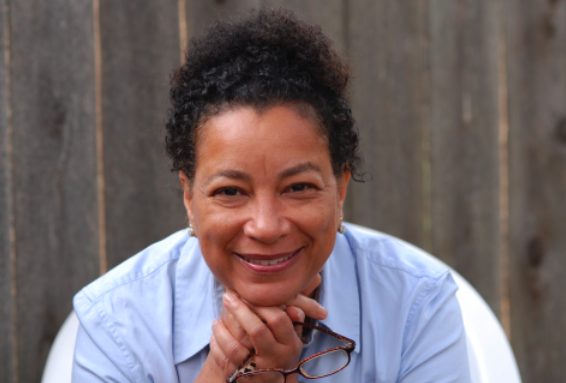
For Kwakiutl Dreher, an independent study course took an unexpected therapeutic turn.
“It was a way to relieve myself of psychological exhaustion from dealing with all of these literary theories I was studying at the time,” said Dreher, an associate professor of English and ethnic studies. “I wanted to create. I wanted to produce.”
So in the back halls of Southern California coffee shops in the late 1990s, when Dreher was working on her doctorate in English literature at the University of California, Riverside, a story began to unfold.
“I would go to these cafes with my laptop and write,” Dreher said. “I’d just imagine and write my stream of consciousness.”
The words on the screen would go on to become the manuscript for a one-woman show, “In a Smoke-filled Room...Color Matters,” which Dreher will perform at 6 p.m., Jan. 24 in the Sheldon Museum of Art.
The performance is directed by Stan Brown, associate professor in the Johnny Carson School of Theatre and Film, and a native of Dreher’s hometown of Columbia, S.C.
Dreher’s Southern upbringing heavily influenced the development of her play, based loosely on the female seamstresses and other vocational artists she knew throughout her childhood and adolescence.
“My fraternal grandmother was a seamstress with only a third-grade education,” Dreher said. “But people in the community came to her to make their clothes.”
Dreher’s play examines the growing undervalue of handcrafted artistry caused by the boom of big business and the mass production of items that used to be made individually over long periods of time.
“I want people to mourn the loss of a simpler time when you would wait for a chair to get made or wait for a gown to be made,” she said. “I want the audience to take away a nostalgia for a time when handicrafts were valued.”
The play follows Azalea Smith, a seamstress by trade but a woman first and foremost, who struggles with her identity as a light-skinned African-American in the South.
“The overarching focus of this is about color and the intraracial dynamics within your own community,” she said. “In this instance, it’s the light-skinned versus the dark-skinned African Americans – how do you deal with that?”
The storyline also addresses the toll that silence can take on an individual who’s been prohibited from sharing his or her story for fear of judgment or misunderstanding.
“When there’s a person in the community and the only things you know about that person have to do with what people say about them, what story would that person tell in the midst of all these scraps and pieces?” Dreher said. “So this play is about listening to our elders and dealing with the consequences of storytelling when this woman gets to share what she’s been holding in and the smoke gets released.”
Through Azalea, the audience bears witness to different intervals of her life, ranging from her birth in the early 1900s up to her work as an elderly seamstress in the 1970s.
As a cast of one, Dreher plays six characters, all with a wide range of personality traits and nuances.
“All of the challenges are really rooted in memory and transitions,” she said. “Consulting with Stan has been a huge help because he’s brilliant.”
Dreher’s collaboration with Brown is not her first effort to utilize the university as a resource to enhance her scholarly and creative endeavors.
When she first arrived at the English department, Dreher shared her project with Stephen Buhler, Aaron Douglas Professor of English and a Shakespearean scholar.
“At the time, he was on the Lincoln Community Playhouse playwriting committee and he showed an interest in my work,” Dreher said. “Scholarship informs my creative work and makes everything worthwhile.”
The input she’s received from colleagues has helped refine the play to be not only performance-ready, but also film-ready in a few years.
“My parents and community molded its youth to be involved,” she said. “I am carrying out that legacy. I see myself really honing this to a point where it’s ready to be filmed and submitted to film festivals.”
Dreher has already taken steps in that direction – in 2010, the play was selected as an alternate for the Los Angeles Women’s Theatre Festival.
“It’s getting there,” she said. “I’ll never forget when I finished the first draft of this. I put my coffee down and cried like a baby because it was so beautiful to finally imagine this woman’s story after having just conversations and snippets.”
— Mekita Rivas, University Communications
More details at: http://www.sheldonartmuseum.org/events_programs/?topic=detail&evnt_id=614